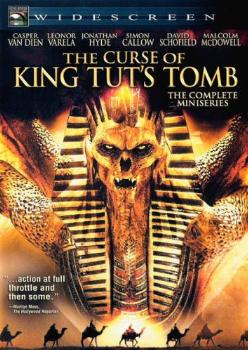Plot
In ancient Egypt, Tutankhamun, the boy pharaoh who is said to have died young, was actually sent by the sun god Ra to protect the people from the demon Set, who escaped from the Underworld and caused chaos in Egypt. With Ra's blessing, Tutankhamun manages to overcome Set and keep the demon under control by breaking an emerald tablet into four pieces and sending the pieces to the far corners of the world. However, the tradeoff is that he must remain in the Underworld.
In 1922, Danny Fremont, an archaeologist, is searching for the last piece of the tablet, which is believed to be in Tutankhamun's tomb. He found the first three pieces earlier, but they were seized from him by his rival, Morgan Sinclair. Sinclair is in the service of the Hellfire Council, a secret committee formed by a group of influential men from around the world, and they wish to use the tablet's powers to achieve their goal of world domination. Sinclair uses the Hellfire Council's influence to damage Fremont's reputation and cause him to lose his job.
Fremont is undaunted by the challenges he faces. With help from his buddies, he manages to convince several others, including a sceptical Egyptologist named Azelia Barakat, to join him in his quest to find Tutankhamun's tomb and the last piece of the tablet. Despite their efforts, the last piece still falls into the hands of Sinclair and the Hellfire Council. Sinclair assembles all four pieces in the tomb, absorbs the tablet's powers, and unleashes Set and the demons of the Underworld. He also gets rid of the Hellfire Council's members later.
Fremont and his companions manage to hold off Sinclair and other enemies and make their way back to the tomb, where they open a portal to the Underworld. In the Underworld, Fremont and his friends succeed in finding and freeing Tutankhamun, but the boy pharaoh is too weak to help them. Meanwhile, Sinclair is absorbed by Set, who then attacks Fremont. At the critical moment, Barakat prays to Ra to empower Tutankhamun and her wish is granted. Tutankhamun springs to life, fights and destroys Set, and brings Fremont and Barakat (the only two survivors) safely out of the Underworld. Before leaving, Tutankhamun thanks them and tells them that "all things are as they should have been". Fremont and Barakat do not understand what he means and they leave the tomb just before it closes by itself.
Back in the streets of Cairo, Fremont and Barakat finally understand what Tutankhamun meant when they see that all the negative events which happened earlier have been reversed: their dead companions are alive and well; Barakat's fiancé is happily married to another woman and has a family. Fremont chances upon Howard Carter and gives him the map to Tutankhamun's tomb; Carter becomes world-famous for his "discovery". At the end, in the Museum of Antiquities, Fremont proposes to Barakat and she agrees to marry him.
Reception
Critical reception for the film upon its release on Hallmark was negative. [3] [8] [9] TV Guide reviewed the film, stating that "the CG-laden miniseries is a gluttonous bore of a tale that is only interesting for the cheesy effects that pop up on the screen every ten or so odd minutes. Otherwise, it's a spot-that-poor-classy actor game, which almost always leads to Malcolm McDowell, who's seen better days in far more worthwhile projects". [10] A reviewer for the Hartford Courant was similarly critical, as they felt that "the thing doesn't even have an ending, preferring to say 'To Be Continued ...' as if it were an old afternoon serial, or a movie we actually cared about". [6]
This page is based on this
Wikipedia article Text is available under the
CC BY-SA 4.0 license; additional terms may apply.
Images, videos and audio are available under their respective licenses.

